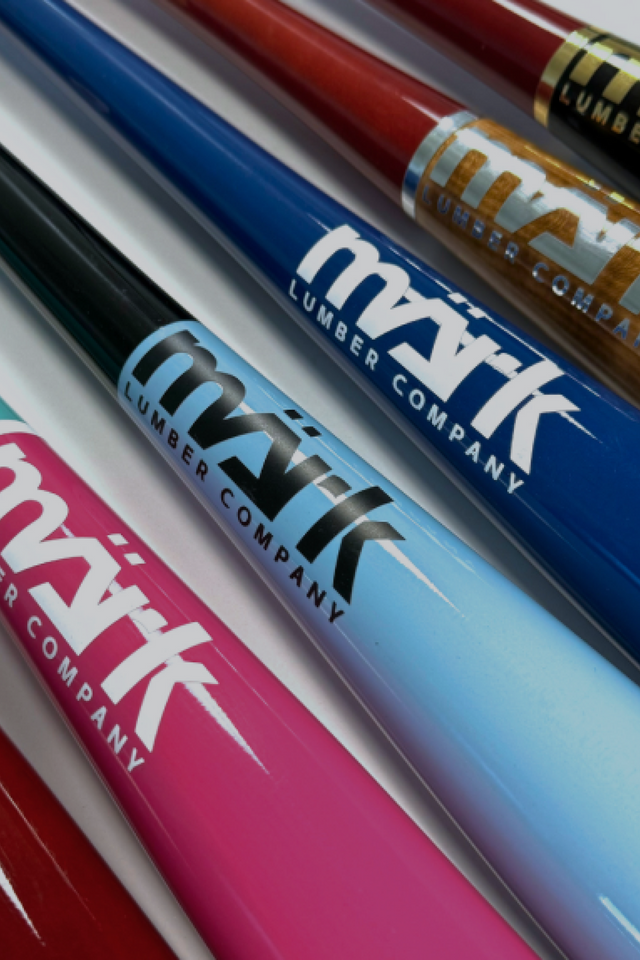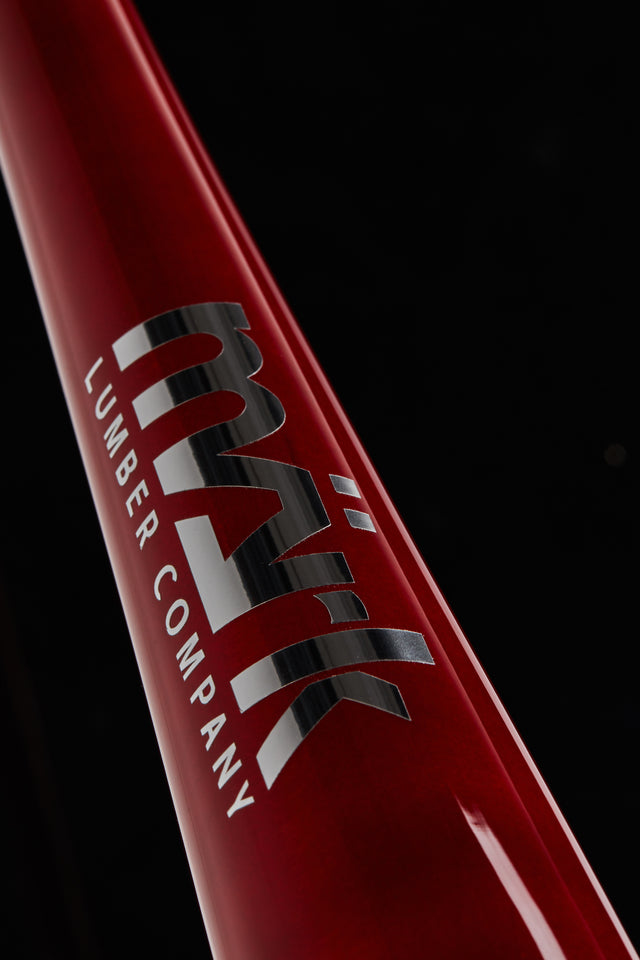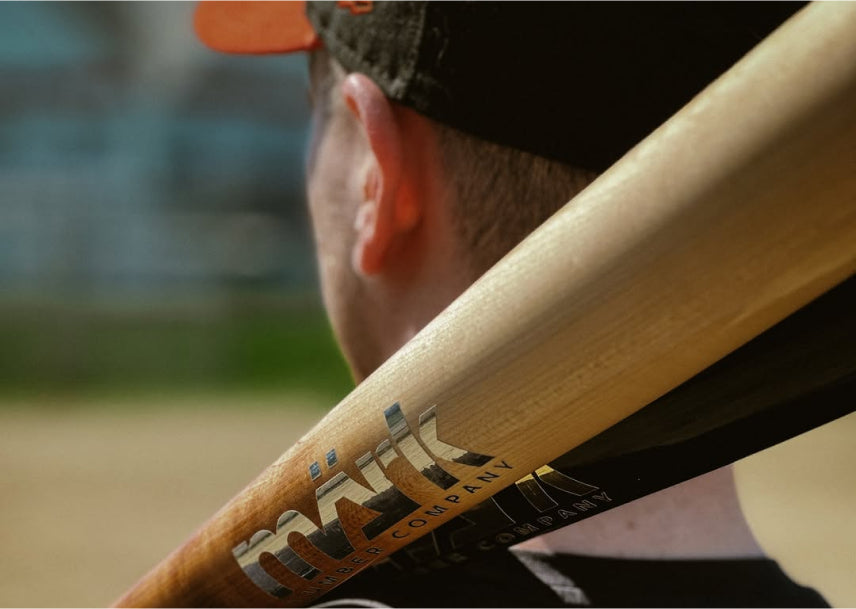
Ink Dot Standard for Wood Bats: What Every Player Should Know
Introduction
If you’ve ever noticed a tiny black mark on the handle of a maple bat and wondered what it means, you’re in the right place. That dot isn’t a logo or decoration—it’s proof the bat passed the ink dot test. This simple check shows how straight the wood fibers run, which tells you a lot about safety and durability. The straighter the grain, the less likely the bat is to fail in a game. That’s why the ink dot standard for wood bats became the norm in pro baseball when maple surged in popularity. It doesn’t measure power or “pop”; that’s what BBCOR bat regulations cover for non-wood bats. The ink dot is about trust—knowing your bat won’t splinter under pressure.
In this guide, we’ll explain what the dot reveals, who needs it, and how bat makers apply it. We’ll also clear up common myths and share simple ways players and coaches can choose better gear.
History and Purpose of the Ink Dot

Maple bats transformed the game. Players appreciated the hardness of the wood and the power it delivered. The problem? Maple doesn’t splinter like ash. Instead, it can snap into large, dangerous pieces. In the late 2000s, fans and players were dodging flying shards, and MLB was facing a safety crisis.
The solution was the ink dot test. Introduced around 2009, it became the standard for maple bats. By placing a drop of ink on the handle, bat makers could quickly see if the wood grain ran straight. If it didn’t, the bat was too weak to be safe.
That small mark ended up changing how bats were made, inspected, and approved. Today, the ink dot is a guarantee that the bat in your hands isn’t just powerful — it’s also safe to swing.
Related: What does an Ink Dot on Baseball Bats Mean?
Rules and Regulations for Wood Baseball Bats
Baseball has always had rules for equipment, but wood bats have special ones because they can break. That’s where the ink dot comes in. It’s easy to confuse it with BBCOR bat regulations, but they’re not the same thing.
The ink dot test is all about wood quality. It shows how straight the wood fibers are. If the slope is more than three degrees, the bat doesn’t pass. BBCOR, on the other hand, applies to metal and composite bats. It measures how much “pop” the bat produces to make sure the game stays fair.
So who needs the ink dot? Any maple or birch bat used in professional baseball. Ash bats don’t because their grain is naturally visible. Youth, fungo, and training bats usually don’t either. But at the pro level, no ink dot means no bat in the box.
Related: The Importance of the Ink Dot Certification in Pro-Quality Baseball
The Science Behind the Ink Dot Test
A wood bat may look solid, but what makes it safe or unsafe is the way its fibers run. This is called the slope of grain. If the fibers run straight, the bat is strong. If they slant too much, the bat is weak.
The ink dot test makes this slope easy to see. A drop of ink is placed 12 inches up the handle. The ink spreads along the fibers, showing the direction they run. A nearly vertical line means the bat passes. A tilted line means trouble.
Here’s the breakdown:
-
0°–2° slope: Excellent strength.
-
2°–3° slope: Still safe, but durability drops a bit.
-
3°+ slope: Fail. Too risky for game use.
That simple test is why players can trust a maple baseball bat ink dot to back them up in the box.
|
Slope of Grain |
Pass/Fail |
Durability |
|
0°–2° |
Pass |
High |
|
2°–3° |
Pass |
Medium |
|
3°+ |
Fail |
Low |
How Bat Makers Apply the Ink Dot

The ink dot isn’t just slapped on. It’s part of a process that starts before the bat even takes shape.
It begins with billet selection. Bat makers hand-split billets, which are logs cut in a way that keeps the grain as straight as possible. That billet is then turned on a lathe to create the bat’s shape. Once it’s smooth and formed, the ink dot goes 12 inches above the knob.
From there, the ink spreads. Craftsmen check the angle of the line. If it’s within the limit, the bat passes. If not, it’s rejected. Only bats that pass move on to finishing: sanding, staining, engraving, and final quality checks.
This step may look simple, but it’s critical. Without it, unsafe bats would slip into games, putting players at risk.
Performance, Safety, and Common Misconceptions
The ink dot has two main benefits: safety and confidence. Players can step into the box knowing their bat won’t snap in half on a routine swing. That peace of mind makes a difference, especially at the pro level, where every pitch matters.
From a performance standpoint, straighter grain equals more durability. The bat lasts longer, and its strength helps transfer energy into the ball. That doesn’t mean the ink dot adds extra power — that’s a myth. It simply ensures the bat can perform the way it was designed.
Some common misconceptions include:
-
“Ink dot means BBCOR certified.” Wrong. They’re unrelated.
-
“All bats need ink dots.” Not true. Only pro-level maple and birch.
-
“Ink dot boosts performance.” No — it ensures safety, not extra pop.
Even with these myths, the truth is simple: the ink dot keeps players safe and bats trustworthy.
Choosing the Right Bat: Players and Coaches Guide
For coaches and players, understanding the ink dot standard can make buying bats easier.
Here’s what to look for:
-
The dot itself: It should be 12 inches from the knob.
-
The line it creates: Nearly vertical is best.
-
The source: If you’re in pro ball, make sure the bat comes from an approved supplier.
For coaches, this knowledge pays off. It prevents injuries, keeps players confident, and ensures the team’s equipment is compliant. For players, it’s about trust. Knowing your bat has passed the ink dot test lets you focus on hitting, not worrying about breakage.
Browse Mark Lumber’s fungo bats designed specifically for coaches.
Mark Lumber: Craftsmanship Backed by the Ink Dot Standard
At Mark Lumber, quality starts at the billet. We hand-select pro-grade maple and birch, turn every model for balance, and verify grain straightness to the same benchmark used in pro ball. If you’re searching for an ink dot test baseball bat, this is exactly what we build—ink dot standard wood bats that deliver consistency, safety, and feel.
You can tailor the bat to your swing—model, length, finish, engraving—without giving up reliability. Every bat is backed by a 45-day warranty and crafted to perform season after season. Whether you’re stepping into the box or running practice, you can swing with confidence knowing your wood baseball bat meets professional expectations.
Conclusion
The ink dot might look small, but it carries a lot of weight. It shows that a bat has been tested, inspected, and approved for safe use at the highest level of the game. Without it, ink dot test baseball bats like those made from maple wouldn’t be trusted in professional baseball.
For players, it means fewer broken bats and more confidence. For leagues, it means safer games. And for bat makers, it’s proof of craftsmanship and quality.
If you’re ready for a bat that meets the ink dot standard and looks as good as it performs, Mark Lumber has you covered. From custom designs to pro-grade stock models, each bat is built with precision, tested for safety, and designed to help you swing with confidence.
FAQs
1- What does the ink dot test on a baseball bat mean?
The ink dot test baseball bat standard shows how straight the wood grain runs through the handle, where bats are most likely to fail. A small drop of ink is placed 12 inches above the knob and wicks along the grain, creating a visible line that reveals the slope. If the line is close to vertical, the bat passes; if it angles beyond a set limit (around three degrees), it fails. This matters because misaligned grain increases the chance of dangerous breaks. In professional baseball, the rule applies to ink dot standard wood bats made from maple and birch. For other levels, the mark functions as a quality signal, indicating stronger grain alignment, better durability, and greater confidence at the plate.
2- Do all wood bats need the ink dot test?
No. Not every wood baseball bat requires an ink dot. The rule primarily applies to maple and birch used at the professional level, where safety standards are strict and inspected. Ash bats typically don’t need the ink dot because their open grain pattern already makes alignment visible without ink. Youth, fungo (coach-use) and training bats usually aren’t covered by the same requirements. That said, many bat makers follow consistent material and inspection practices across product lines, so you may still see an ink mark outside pro contexts. Even when it’s not mandatory, an ink dot provides assurance that the bat’s grain was evaluated, which can help players and coaches choose equipment with a lower risk of breakage and a longer usable life.
3- How does the ink dot improve player safety?
The ink dot reduces risk by identifying billets with poor grain alignment before they become game bats. Misaligned grain concentrates stress and can cause sudden, sharp breaks. With the ink dot standard, makers test slope in the handle area—where most failures originate—so bats with excessive slope are removed from play. This became especially important as maple baseball bat ink dot requirements were adopted; maple’s break pattern tends to produce larger fragments than ash. Since the test highlights unsafe slopes early, overall breakage rates and dangerous shards have decreased in higher levels of play. While the ink dot isn’t a performance booster, it is a practical safety screen that leads to sturdier, more predictable bats and more confidence for hitters, coaches, umpires, and spectators alike.
4- What’s the difference between BBCOR bat regulations and the ink dot standard?
BBCOR bat regulations and the ink dot test address different problems. BBCOR applies to non-wood bats (aluminum or composite) and limits batted-ball speed by controlling trampoline effect; it’s a performance standard meant to keep play fair and fields safe. The ink dot standard wood bats rule applies to maple and birch and focuses on durability and safety, not pop. By revealing the slope of the grain in the handle, the ink dot helps filter out billets likely to fail dangerously. Think of it this way: BBCOR governs how “hot” a metal or composite bat can be, while the ink dot verifies how structurally sound a wood bat is. They don’t overlap, but together they create clearer expectations for equipment across levels of baseball.
5- Can I buy custom bats that pass the ink dot test?
Yes. Many manufacturers offer ink dot test baseball bats that meet professional-level durability checks, including custom builds. The process typically starts with selecting straight-grain billets (often hand-split) and shaping the model to the player’s preferred profile and balance. After turning, the ink dot is applied to confirm an acceptable grain slope in the handle; bats that don’t pass aren’t released as game bats. Customization usually covers model, length, drop/weight, colour and finish, and sometimes engraving, while the grain-quality requirement stays constant. Whether you choose maple or birch, a clear, nearly vertical ink line indicates that the bat met the inspection threshold. That makes it a practical option for players who want a tailored feel, consistent durability, and confidence under game conditions without compromising safety.







